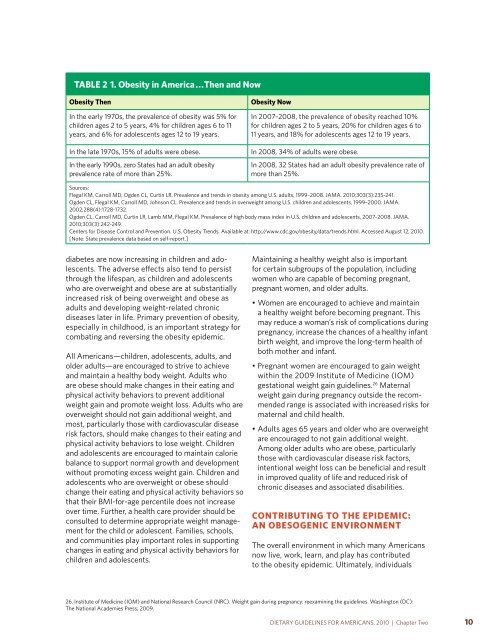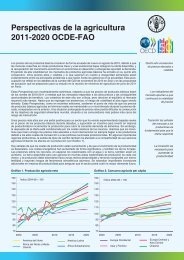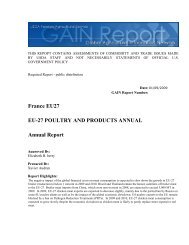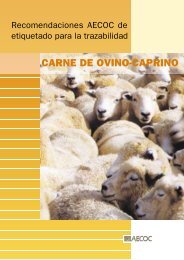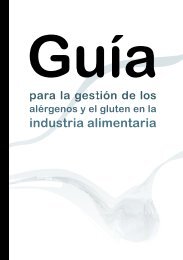Dietary Guidelines for Americans - SchoolNutritionAndFitness.com
Dietary Guidelines for Americans - SchoolNutritionAndFitness.com
Dietary Guidelines for Americans - SchoolNutritionAndFitness.com
- No tags were found...
Create successful ePaper yourself
Turn your PDF publications into a flip-book with our unique Google optimized e-Paper software.
taBle 2 - 1. obesity in america ...then and nowobesity thenIn the early 1970s, the prevalence of obesity was 5% <strong>for</strong>children ages 2 to 5 years, 4% <strong>for</strong> children ages 6 to 11years, and 6% <strong>for</strong> adolescents ages 12 to 19 years.In the late 1970s, 15% of adults were obese.In the early 1990s, zero States had an adult obesityprevalence rate of more than 25%.obesity nowIn 2007–2008, the prevalence of obesity reached 10%<strong>for</strong> children ages 2 to 5 years, 20% <strong>for</strong> children ages 6 to11 years, and 18% <strong>for</strong> adolescents ages 12 to 19 years.In 2008, 34% of adults were obese.In 2008, 32 States had an adult obesity prevalence rate ofmore than 25%.Sources:Flegal KM, Carroll MD, Ogden CL, Curtin LR. Prevalence and trends in obesity among U.S. adults, 1999–2008. JAMA. 2010;303(3):235-241.Ogden CL, Flegal KM, Carroll MD, Johnson CL. Prevalence and trends in overweight among U.S. children and adolescents, 1999–2000. JAMA.2002;288(4):1728-1732.Ogden CL, Carroll MD, Curtin LR, Lamb MM, Flegal KM. Prevalence of high body mass index in U.S. children and adolescents, 2007–2008. JAMA.2010;303(3):242-249.Centers <strong>for</strong> Disease Control and Prevention. U.S. Obesity Trends. Available at: http://www.cdc.gov/obesity/data/trends.html. Accessed August 12, 2010.[Note: State prevalence data based on self-report.]diabetes are now increasing in children and adolescents.The adverse effects also tend to persistthrough the lifespan, as children and adolescentswho are overweight and obese are at substantiallyincreased risk of being overweight and obese asadults and developing weight-related chronicdiseases later in life. Primary prevention of obesity,especially in childhood, is an important strategy <strong>for</strong><strong>com</strong>bating and reversing the obesity epidemic.All <strong>Americans</strong>—children, adolescents, adults, andolder adults—are encouraged to strive to achieveand maintain a healthy body weight. Adults whoare obese should make changes in their eating andphysical activity behaviors to prevent additionalweight gain and promote weight loss. Adults who areoverweight should not gain additional weight, andmost, particularly those with cardiovascular diseaserisk factors, should make changes to their eating andphysical activity behaviors to lose weight. Childrenand adolescents are encouraged to maintain caloriebalance to support normal growth and developmentwithout promoting excess weight gain. Children andadolescents who are overweight or obese shouldchange their eating and physical activity behaviors sothat their BMI-<strong>for</strong>-age percentile does not increaseover time. Further, a health care provider should beconsulted to determine appropriate weight management<strong>for</strong> the child or adolescent. Families, schools,and <strong>com</strong>munities play important roles in supportingchanges in eating and physical activity behaviors <strong>for</strong>children and adolescents.Maintaining a healthy weight also is important<strong>for</strong> certain subgroups of the population, includingwomen who are capable of be<strong>com</strong>ing pregnant,pregnant women, and older adults.• Women are encouraged to achieve and maintaina healthy weight be<strong>for</strong>e be<strong>com</strong>ing pregnant. Thismay reduce a woman’s risk of <strong>com</strong>plications duringpregnancy, increase the chances of a healthy infantbirth weight, and improve the long-term health ofboth mother and infant.• Pregnant women are encouraged to gain weightwithin the 2009 Institute of Medicine (IOM)gestational weight gain guidelines. 26 Maternalweight gain during pregnancy outside the re<strong>com</strong>mendedrange is associated with increased risks <strong>for</strong>maternal and child health.• Adults ages 65 years and older who are overweightare encouraged to not gain additional weight.Among older adults who are obese, particularlythose with cardiovascular disease risk factors,intentional weight loss can be beneficial and resultin improved quality of life and reduced risk ofchronic diseases and associated disabilities.contriButing to the ePideMic:an oBesogenic environMentThe overall environment in which many <strong>Americans</strong>now live, work, learn, and play has contributedto the obesity epidemic. Ultimately, individuals26. Institute of Medicine (IOM) and National Research Council (NRC). Weight gain during pregnancy: reexamining the guidelines. Washington (DC):The National Academies Press; 2009.DIETARY GUIDELINES FOR AMERICANS, 2010 | Chapter Two 10


